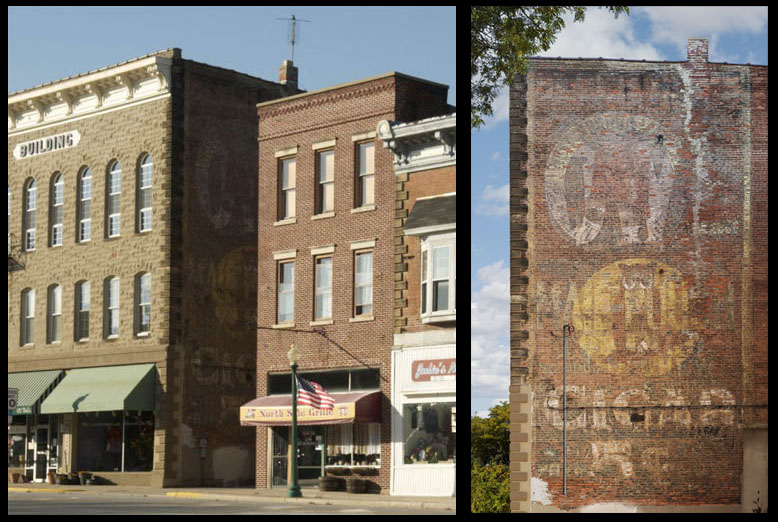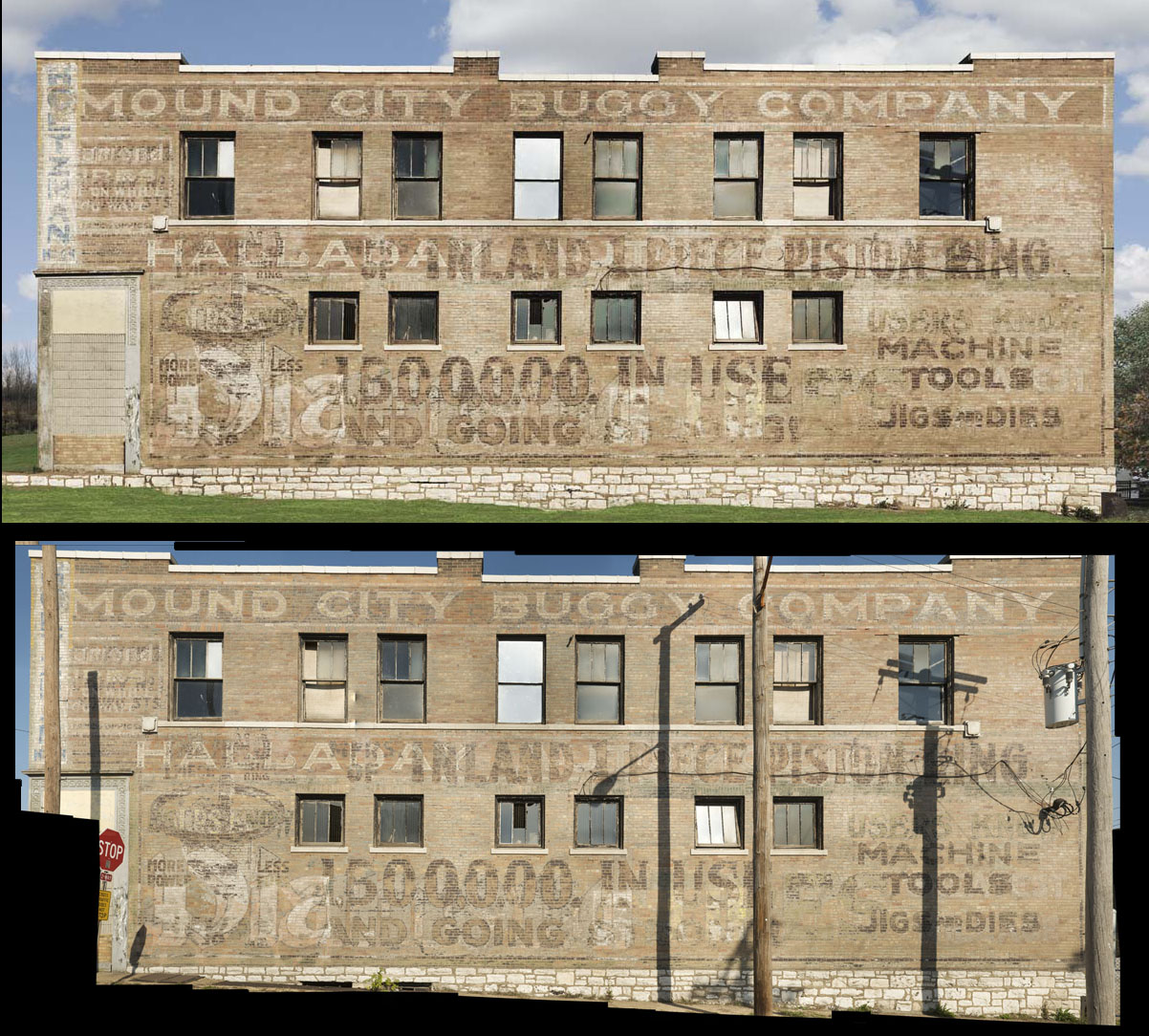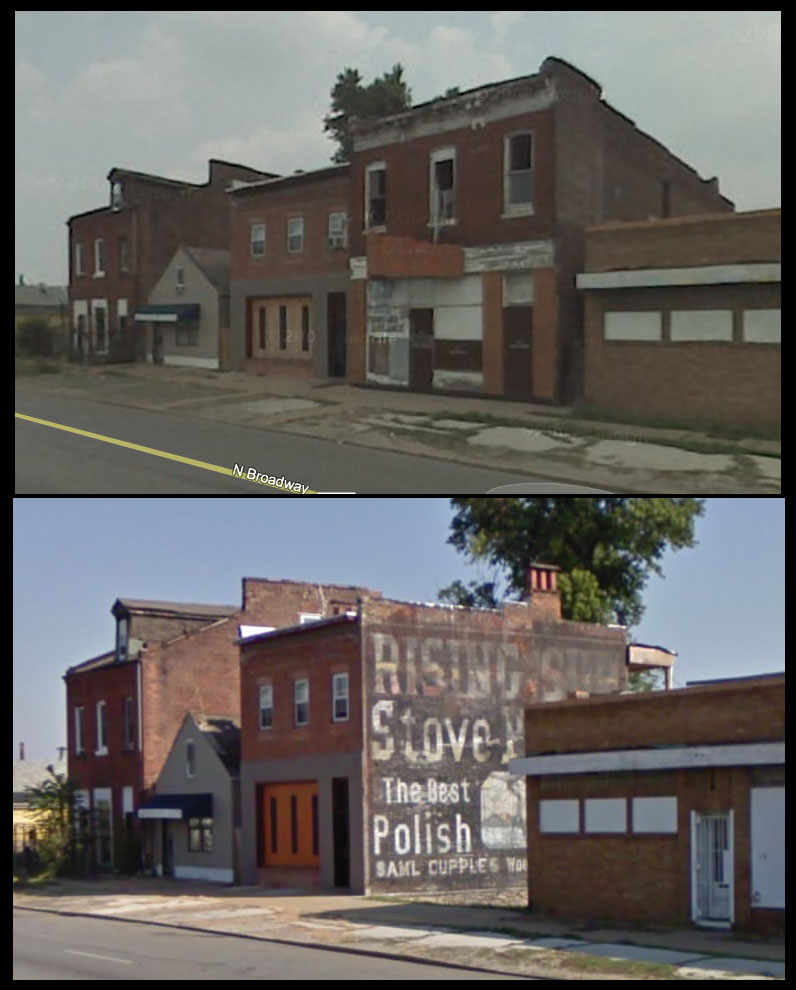
What are Ghost Signs?
Ghost signs, also known as faded ads, are the disappearing painted letters and illustrations on the sides of old buildings. They once lined the streets of almost every town and city (like downtown Los Angeles to the left). I suspect that practially every brick wall larger than ten feet square was once covered by an advertisement.
They are the things that everyone sees, but no one notices. I have asked people about the signs on a building, only to find that they have never seen them, even though they have lived in the town (or even next door) for years.
Many of the signs are over 100 years old. There are many reasons why there are still there. First of all, it's the paint. Good old lead-based paint! It apparently kept out water and sunlight better than modern paints (besides being very toxic). Then there are towns, or parts of towns, that have been in a depressed economy for decades. They just can't afford the paint to cover the signs or to restore them. There are other towns that embrace their signs and keep them as part of their heritages. Other towns are being renovated as part of urban renewal - people like the signs, but don't like the faded look so they restore them. Other towns just demolish the old buildings, or paint over the signs. Then there are the signs that have been preserved under plaster or by other buildings for years and are then revealed in a near pristine state. Those signs are the ultimate prize for they reveal the best original color references and detail.
I do not include much historical information about these signs on this site. I only include unique tidbits I picked up from discussions with local people and building owners along the way. Instead, I include references to other sites, rather than plagarize their contents. For some very good historical insight, including information about some of the Wall Dogs (as they are known) who painted the signs, check out the reference books below.
I strongly encourage people to visit these small towns. Each town is different. People are usually extremely interested in what you are doing, especially if you have a long telephoto lens on your camera. I have some exotic equipment - some so exotic my wife jokes I could easily end up either in the local newspaper or in the local jail. Visit the towns, talk to the people, spend money.
What makes a good Ghost Sign?
Here is a list of some of things that I think make ghost signs interesting, and why some are more interesting than others.
The sign should not be restored or recreated. Many signs have been restored, sometimes badly, sometimes so well that it is difficult to tell if the sign is or is not original. I found many restorations were more recreations, having no resemblance to the original graphics.
The sign should be authentic. Many signs are new creations. For example, Central City and Blackhawk, Colorado, have added murals that look like old signs but advertise non-existent products. I also ran into some signs in New Mexico that were painted by the art department for a motion picture. Some of these are intentionally distressed to look old.
The sign should contain something interesting or unique. There are lots of interesting features of signs. I love the 'Where's Waldo' type of signs with the overlapping graphics making deciphering the contents a challenge.
There are some products, such as Coca Cola and Mail Pouch Tobacco, whose signs have become icons by themselves.
There are some signs that are interesting for their period fonts or graphics.
The signs should not be too recent. My guideline is that any sign that has more than six digits in the phone number is too new.
There are signs for long forgotten and quaint products, such as various patent medicines, that are time-capsules of another era. One of my favorites is the 'Dr. Hoffman's Red Drops' sign in St. Louis, Missouri, that cures 'Colic, Cramps, and Cholera Morbus'.
And then there are the signs with some social commentatary unintentionally built in, such as the sign on a cafe in Huntington, Oregon, that states 'White Help Only'.
There is the intially mysterious sign in Lemoore, Calfornia, that advertises 'Cyrus Noble of the three sworn enemies'. Cyrus Noble was a bourbon started in San Francisco in the 1850's. My interpretation is that this sign, probably painted around 1910, refers to the three sworn enemies of the Women's Temperance Movement (Alcohol, Gambling, and Prostitution), proudly boasting their inclusion in that list as a positive for their product.
I particularly like the sign in Prescott, Arkansas that includes 'Cardui, the Women's Tonic' alongside 'Henry George Cigar - I am for Men'. Cigars for Men, Tonics for Women. I wonder if the tonics were to help the women put up with the cigar smoke?


How I Photograph Ghost Signs
There would be no point in photographing these signs, most of which have been photographed before, unless I added something unique to the mix.
First, I photograph all of the signs in high resolution. That is, depending on the size of the sign, I have shot as many as 200 separate photos using a long focal length (up to 1200mm) to preserve as much detail as possible. These photos are then stitched together using several pieces of software. There are several reasons for shooting in high resolution. First of all, my final prints are a minimum of 24x36 inches, and most can be blown up to mural size. Second, since I geometrically correct the signs to appear to be shot straight on, there is usually a fairly severe warping of the images. (see the Owl Cigar image to the left, located down a narrow alley) Only by shooting more resolution than is needed for the final product can I preserve detail in the result.
Second, I digitally remove all of the clutter in front of the sign (as in the Mound City Buggy Company image). Usually that includes powerpoles and numerous wires, sometimes shadows, frequently other buildings. I usually have to shoot from many different locations around a building to get complete coverage of a single sign. I occasionally ask for and get permission to access private property and rooftops. I have combined 400mm shots with 12mm shots in the same final image. I use digital and shooting methods which I applied regularly while working as a Visual Effects Supervisor in Hollywood.
Third, I usually replace the backgrounds and sky around the signs. Purists might not approve, but since many of these are shot at odd angles, it is not possible to keep the original backgrounds after the warping process. I photograph appropriate backgrounds for the region of the country where the sign is located ... no palm trees behind signs in Boston.
Last, I enhance the contrast and color of the sign to make it more legible. I try not to get too far from the original, but some preferential color enhancements help disentangle the overlapping text.
The result of all of these steps is to create a high quality archival copy of the original sign. I alter the backgrounds and remove the clutter in order to produce a final image which people might actually like to display on their walls.
Since it takes time to completely assemble each final sign photograph, MOST OF THE SIGNS PRESENTED IN THESE WEB PAGES ARE NOT IN THEIR FINAL FORMAT. Some of the low-resolution temps are only partially assembled. Although as a photographer I should be showing only final works, I decided to include signs even in their rough state so that people could at least see where they are, even if I haven't finished them yet. I am concentrating on data collection - photographing the signs before they disappear, and I'll continue with the processing as time permits. I will update finished signs as they are completed. I have many more signs than are currently in these pages. In fact, these pages only include about 50% of the signs I have photographed, so check back later as I add more.
How does one locate Ghost Signs?
Like many things these days, the first place to look to find ghost signs is on the internet.
First, I want to give a HUGE thanks to people who have posted these signs on the internet. I want to give an ENORMOUS thanks to people who also include the actual locations of the signs.
I have also found signs driving, and also using Google Street View. There are some simple heuristics for finding signs. About 30 percent of the signs appear on buildings with addresses between 300 N. Main and 300 S. Main (or E/W) in many towns. Other common streets are Broadway, a street with the name of the town or adjacent town, Railroad Ave. (where people first arrived in a town), or Commercial Ave.
When you find a building with a sign, be sure to walk around the building to look for other signs. If the building owners over the years didn't paint over this sign, they probably didn't paint over the other signs.
Before driving 1000 miles to see a sign, make sure it is there. Many are already gone. A few online references to signs have them located in the wrong town. Usually, I find them in an adjoining town. It is easy to see how this happens. When I am travelling, the towns blur together. At the time I am photographing the sign, I am sure I'll remember where it was. Wrong. I now religiously photograph a slate with the name of the town before shooting in that town.

Preserving and Restoring Ghost Signs
Ghost signs are rapidly disappearing. In the first eighteen months since I started seriously photographing them, at least half a dozen signs been demolished or painted over. Because of my paranoia about missing a sign, I am trying to capture as many signs as possible as quickly as possible.
The fading of the paint is, of course, part of the problem. However, many of the oldest signs, thanks to the durable lead paint, last very well. I have observed that the oldest paints seem to have permeated the bricks themselves, like a stain. They almost act like a tattoo. Multiple paintings repeatedly stained the same area, so the multi-layer signs result. Newer paints, including those used for restoration, peel off.
There are some signs that have been unintentionally preserved. Two screen grabs from Google Street View show the revealing of a beautiful Rising Sun Stove Polish sign in St. Louis by the demolition of an adjacent building. Many are preserved by a plaster or stucco covering. Many are being revealed by the peeling of the less durable modern paints. There are many signs like this around the country.
In Salina, Kansas, there is a sign that was revealed a couple of years ago during an urban renewal process. In an attempt to preserve the sign, a painter put a coating of some sort over the surface. That coating is now peeling off taking paint with it. A professional sign painter believes that doing nothing would have been best.
There is a vigorous debate about whether these signs should be left as is or restored to their original condition. My personal feeling is that restoring ghost signs to their original colors is a bad thing. To me, an entire town begins to resemble a Disneyland-like recreation.
However, a nice counter-example to that attitude is a labor-of-love restoration of the 'American Beauty' sign described in the book on Colorado Wall Dogs below. Multiple layers were preserved, and missing sections recreated to match. I photographed the sign, but only after the restoration.
Published Books:
Haas, Cynthia Lea, and Jeff Holder (photographs), Ghost Signs of Arkansas, University of Arkansas Press, 1997.
Russell, Laura, Colorado Wall Dogs: Ghost Signs Across Colorado, Second Edition, Simply Books, Ltd., 2006
Stage, Wm, and Arthur Krim (designer), Ghost Signs: Brick Wall Signs in America, Cincinnati, Ohio : ST Publications, 1989
Web Resources:
Flickr : search on Ghost Sign or Faded Ads to get started. Be sure to use quotes around Ghost Sign or you'll get lots of paranormal stuff.
Waymarking : These web pages are particularly useful since they include the GPS coordinates of the signs. Copy the coordinates, paste them into google maps, and the sign is located. If you then move the little man icon to get the street view, you can verify that the sign might still be there.
Ghost Signs in Butte, Montana, from the Montana Standard
More to be added.......